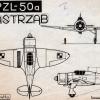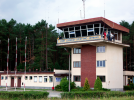Virgin Australia AT72 near Sydney on Feb 20th 2014, control disagreement causing excessive G-forces injures cabin crew
A Virgin Australia Regional Avions de Transport Regional ATR-72-212A, registration VH-FVR performing flight XR-657/VA-657 from Canberra,AC to Sydney,NS (Australia), was on approach to Sydney descending through 8000 feet for 6000 feet when the aircraft encountered what was rated severe turbulence by the flight crew causing serious injuries, a broken leg, to one of the flight attendants. The flight crew declared PAN, levelled off at 6000 feet to work checklists, then continued the approach for a safe landing on Sydney's runway 16R about 15 minutes later.
Australia's TSB reported the aircraft encountered severe turbulence near Sydney resulting in a serious injury to a flight attendant. An investigation has been opened into the serious incident.
The French BEA reported in their weekly bulletin the ATSB rated the occurrence an accident, a flight attendant received serious injuries when the aircraft encountered severe turbulence. The ATSB is investigating.
In the week of Apr 14th to 18th 2014 the Australian TSB released their weekly summary of Mar 7th 2014 listing another event involving VH-FVR in Albury,NS (Australia) on Feb 25th 2014, which is being claimed to have been a bird strike. The ATSB states without further details: "During a post flight inspection, substantial damage to the aircraft's tail assembly was detected. The investigation is continuing", however identifies the investigation number as AO-2014-032, which is the investigation opened for the severe turbulence encounter of Feb 20th 2014. The Aviation Herald contacted the ATSB asking for clarification, whether the accident number was in error, however did not receive reply so far, neither during the Easter week (Apr 14-18) nor the first two working days after Easter. It thus needs to remain unclear, whether the event on Feb 25th 2014 caused any damage at all and whether the ATSB sees the substantial damage to the tail assembly as result of a new accident or as result of the previous turbulence encounter of Feb 20th 2014. It is interesting to note however, that there is no new investigation listed open for the occurrence of Feb 25th 2014 - however, the hard landing accident of Fiji Airways A332 at Sydney, see Accident: Fiji A332 at Sydney on Mar 18th 2014, hard landing, has not been listed as open investigation so far, too.
VH-FVR had performed flight XR-1174/VA-1174 from Sydney,NS to Albury on Feb 25th 2014. The aircraft has not been seen in service since Feb 25th 2014 (including Apr 22nd 2014, 56 days later).
On Apr 23rd 2014 the ATSB sent their reply to The Aviation Herald's questions clarifying the event on Feb 25th 2014 is being considered a second accident, both accidents being investigated within the same investigation, and stated:
Investigation AO-2014-032 encompasses two accidents that occurred to the same aircraft, VH-FVR
Those accidents are:
- a turbulence event on 20/2/2014 (ATSB reference number 201400786)
and
- substantial damage detected on 25/2/2014 (ATSB reference number 201400985)
Both of these accidents are being considered as part of the ATSB's investigation. The ATSB is working with the operator and the aircraft manufacturer to understand the chain of events that led to the damage sustained by the aircraft.
On Jun 10th 2014 the ATSB released a preliminary brief stating, that the investigation had been opened on the assumption of severe turbulence but dropped the suspect of turbulence due to no significant weather around the Sydney aerodrome at the time of the occurrence.
The aircraft was on approach to Sydney, the crew had briefed for a landing on runway 16R but later were advised to expect a landing on runway 16L (non-standard) which required the navigation aids to be retuned and the approach plates to be swapped. The first officer, pilot flying, was using the autopilot in vertical speed mode at a selected speed of 235 KIAS (max operating speed 250 KIAS). The fasten seat belt sign was illuminated and the crew was awaiting the cabin clear indication from the cabin crew, when the aircraft descended through 8500 feet. The crew observed the airspeed of the aircraft rapidly increasing with an excessive speed trend. The first officer, concerned the aircraft might overspeed, disconnected the autopilot and manually rose the nose of the aircraft, the captain deemed the control inputs insufficient to control the airspeed and manually pulled the yoke but did not verbalize that he took control of the aircraft. The first officer was aware however and took his hands off the control yoke, but then became concerned with a very high nose up attitude of the aircraft and began to push the yoke.
Suddenly a high vertical acceleration (around +1.8G) was felt, the controls felt different and spongy, warning indications appeared. The crew verified the aircraft was in a stable descent at 230 KIAS, then checked the indications which included a "pitch disconnect" indicating the left and right hand elevator control systems had de-coupled permitting the left hand and right hand elevators to move independently. The crew worked the pitch disconnect checklist, both elevators appeared to be free, however, the captain took control of the aircraft and reduced the airspeed to 180 KIAS as advised in the checklist.
In the meantime the crew was notified that a flight attendant had injured her leg, the crew declared PAN and requested runway 16R which was assigned to the flight. The captain performed a visual approach and manual landing with airspeed, configurations and power settings typical for a day VFR landing.
After shutdown the crew performed the tasks of reconnecting the pitch controls, an ambulance arrived about 10 minutes after reaching the parking position and took the injured flight attendant to a hospital. The ATSB was advised of a turbulence event and based on the degree of injury opened an investigation.
The ATSB reported that following the occurrence flight the flight crew advised maintenance of the elevator disconnect and a possible overspeed. Maintenance subsequently determined from the onboard equipment that there had been no overspeed event, however, the aircraft had pulled +3.34G exceeding the permitted limit. The maintenance engineer performed a walk around but did not notice any damage. The crew entered the pitch disconnect and a moderate turbulence event into the aircraft log book.
Another maintenance engineer later the day took over understanding from the maintenance duty engineers that the aircraft had suffered a moderate turbulence event and a pitch disconnect. Another engineer had already performed quite a detailed walk around with no damage found, and he was supposed to perform a turbulence inspection, which included a visual check of the fuselage, wings, tailplane and irrespective of the other findings a detailed inspection of the wing attachment fittings. Over night the engineer removed some of the aircraft interior to get access to the wing attachment fittings, subsequently inspected the rear fuselage and tail plane using a torch light and finished the work by about 6am with no defects found and the aircraft returned to service.
The aircraft subsequently flew 13 sectors until the approach to Albury on Feb 25th, when the crew approached the aerodrome in close proximity to birds and suspected a bird strike after the pitch control system performed erratically after landing while on the ground, see Accident: Virgin Australia AT72 at Albury on Feb 25th 2014, suspected bird strike.
The ATSB reported that no evidence of a bird strike was found, the aircraft manufacturer however determined that the damage to the tailplane had been the result of the occurrence on Feb 20th. On this basis the ATSB included the Feb 25th event into the investigation into the Feb 20th 2014 event.
The ATSB reported the initial examination results as: the first officer used pitch trim to bring the nose up, however, the airspeed increased again and both first officer and captain pulled the yoke. When the vertical load increased through +1.8G the first officer began to push the yoke, the differential forces applied to the left and right yoke were sufficient to generate the pitch disconnect.
The ATSB reported: "The aircraft manufacturer inspected the aircraft and found broken carbon plies, cracked joint sealant, and deformation in and around the area where the horizontal stabiliser attaches to the vertical stabiliser (Figures 2 and 3). There was also some minor damage to the rudder. The damage was assessed as being consistent with an overstress condition. Subject to further assessment and non-destructive testing, the aircraft manufacturer recommended replacement of the horizontal stabiliser, elevators, and vertical stabiliser."
The damage to the left and right hand stabilizer (Photo: ATSB):
Detail of damage at the left tail plane attachment, fairing removed (Photo: ATSB):
http://avherald.com/h?article=470e13a6














Komentarze